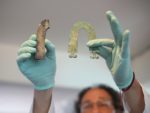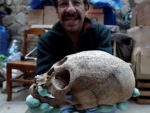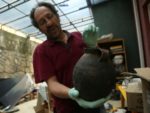 The remains of more than 100 individuals and grave goods have been discovered in a quarry near the modern-day town of Viacha, Bolivia, 18 miles southwest of La Paz. Archaeological material was first found at the site by miners three months ago. They reported it to the authorities and Bolivian government archaeologists began official excavations.
The remains of more than 100 individuals and grave goods have been discovered in a quarry near the modern-day town of Viacha, Bolivia, 18 miles southwest of La Paz. Archaeological material was first found at the site by miners three months ago. They reported it to the authorities and Bolivian government archaeologists began official excavations.
They first encountered two tombs in an underground necropolis carved into the limestone. One chamber contained about 108 funerary bundles. It had been looted and the human remains had suffered significant deterioration, but many grave goods still remained. A small circular hole just 27.5 inches in diameter opened to a chimney nine feet deep. When archaeologists lowered themselves down, they discovered another two tombs, these intact and unlooted.
 There were wood and pottery artifacts in the tombs, and more than 150 pieces of bronze jewelry — necklaces, bracelets, brooches, women’s hair ornaments and two rare u-shaped headbands worn by nobility. Also in the tomb with the bundles were 30 intact pottery vessels of a type used by the Inca for burial rites. Some of the skulls are elongated, evidence of intentional cranial deformation, a common practice in the Americas (and world-wide) that was often a signifier of high social status. The skulls and diverse artifacts indicate people on different rungs of the social ladder were all buried together in the communal graves.
There were wood and pottery artifacts in the tombs, and more than 150 pieces of bronze jewelry — necklaces, bracelets, brooches, women’s hair ornaments and two rare u-shaped headbands worn by nobility. Also in the tomb with the bundles were 30 intact pottery vessels of a type used by the Inca for burial rites. Some of the skulls are elongated, evidence of intentional cranial deformation, a common practice in the Americas (and world-wide) that was often a signifier of high social status. The skulls and diverse artifacts indicate people on different rungs of the social ladder were all buried together in the communal graves.
 The burials date to around 1100-1200 A.D. in the period after the decline of the Tiwanaku Empire which had been the dominant polity in western Bolivia between 600 and 1000. They belonged to the Pacajes people, part of the Aymara kingdom which spread over the Andean highlands of western Bolivia, southern Peru and northern Chile from at least 1200. The area was conquered by the Inca during the reign of Huayna Capac (1493–1524) who expanded the empire to its greatest extent before dying of the smallpox the Spanish brought to America.
The burials date to around 1100-1200 A.D. in the period after the decline of the Tiwanaku Empire which had been the dominant polity in western Bolivia between 600 and 1000. They belonged to the Pacajes people, part of the Aymara kingdom which spread over the Andean highlands of western Bolivia, southern Peru and northern Chile from at least 1200. The area was conquered by the Inca during the reign of Huayna Capac (1493–1524) who expanded the empire to its greatest extent before dying of the smallpox the Spanish brought to America.
 Little is known about when the Inca conquered the Aymara and exactly what the power dynamics were. It’s believed the Aymara had some level of autonomy. The discovery of Inca pottery in the Pacajes tombs is therefore of major historical significance as it is a unique find that attests to the blending of cultural practices after the Inca take-over in the 15th century.
Little is known about when the Inca conquered the Aymara and exactly what the power dynamics were. It’s believed the Aymara had some level of autonomy. The discovery of Inca pottery in the Pacajes tombs is therefore of major historical significance as it is a unique find that attests to the blending of cultural practices after the Inca take-over in the 15th century.
The remains, especially the soft tissues, quickly began to deteriorate further when exposed to microorganisms, humidity and saline air, so archaeologist have removed the contents of the tombs to an archaeological center where they will be studied and conserved in controlled conditions. At this point, the remains and artifacts have not yet been declared national patrimony which means the local municipality of Viacha bears the responsibility of finding a permanent place for them that will provide the conditions for their preservation.